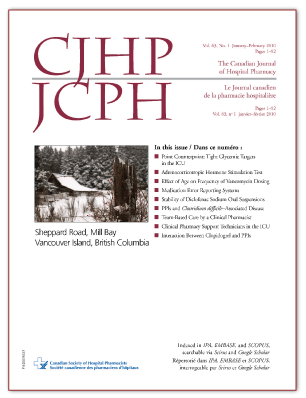Association Between Use of Proton Pump Inhibitors and a <em>Clostridium difficile</em>– Associated Disease Outbreak: Case–Control Study
DOI:
https://doi.org/10.4212/cjhp.v63i1.866Keywords:
antibiotic, Clostridium difficile, outbreak, proton pump inhibitor, risk factor, antibiotique, éclosion de Clostridium difficile, inhibiteur de la pompe à protons, facteur de risqueAbstract
ABSTRACT
Background: The use of proton pump inhibitors (PPIs) has been implicated as a potential contributor to the development of Clostridium difficile–associated disease (CDAD) because of the ability of these drugs to substantially reduce the bactericidal effect of gastric acid. This study focused on the impact of PPIs, among other known risk factors, during an outbreak of CDAD in a hospital setting.
Objectives: The primary objective was to determine whether there was an association between current use of a PPI and the CDAD outbreak. Secondary objectives were to evaluate any correlations between the CDAD outbreak and past use of PPIs, use of antibiotics, diabetes mellitus, enteral feeding, cancer, gastrointestinal surgery, inflammatory bowel disease, and previous care or residence in an institutional setting.
Methods: A retrospective case–control study was conducted. One hundred and fifty cases of hospital-acquired Clostridium difficile were identified. Patients were individually matched to controls for age, sex, date of admission to hospital, and hospital unit. The groups were compared with respect to each exposure.
Results: Eight case patients could not be matched with suitable controls. Therefore, data from 142 cases and 142 controls were analyzed. There was no association between current use of a PPI and the CDAD outbreak (odds ratio [OR] 1.0, 95% confidence interval [CI] 0.99–1.01). Similarly, there was no correlation between the CDAD outbreak and diabetes, enteral feeding, cancer, gastrointestinal surgery, inflammatory bowel disease, or previous care or residence in an institution. However, the development of CDAD was positively associated with use of antibiotics within the 30 days preceding the infection (OR 12.0, 95% CI 4.0–35.7) and with past use of a PPI (OR 2.4, 95% CI 1.4–4.3).
Conclusions: The development of CDAD during a hospital outbreak was associated with use of antibiotics and with past, not current, use of PPIs.
RÉSUMÉ
Contexte : L’emploi des inhibiteurs de la pompe à protons (IPP) jouerait un rôle dans l’apparition des maladies associées au Clostridium difficile (MACD) à cause de leur capacité à réduire considérablement l’effet bactéricide de l’acide gastrique. Cette étude s’est penchée sur le rôle des IPP, parmi d’autres facteurs de risque connus, durant une éclosion de MACD dans un hôpital.
Objectifs : Le principal objectif était de déterminer s’il existait un lien entre l’utilisation actuelle d’un IPP et l’éclosion de MACD. Les objectifs secondaires étaient d’évaluer les corrélations entre l’éclosion de MACD et l’utilisation antérieure d’IPP, l’utilisation d’antibiotiques, le diabète sucré, l’alimentation entérale, le cancer, les interventions chirurgicales gastrointestinales, la maladie inflammatoire de l’intestin et le fait d’avoir séjourné ou de vivre dans un établissement.
Méthodes : On a effectué une étude cas-témoins rétrospective. On a répertorié 150 cas de maladies nosocomiales associées au Clostridium difficile. Les patients ont été appariés individuellement à des témoins en fonction de l’âge, du sexe, de la date d’hospitalisation et de l’unité de soins. Les groupes ont été comparés pour ce qui est de chaque exposition.
Résultats : Huit cas n’ont pu être appariés à des témoins convenables. Les données de 142 cas et de 142 témoins ont donc été analysées. Aucune association n’a été établie entre l’utilisation actuelle d’IPP et l’éclosion de MACD (risque relatif approché [RRA] 1,0, intervalle de confiance à 95 % [IC] 0,99-1,01). De même, on n’a observé aucune corrélation entre l’éclosion de MACD et le diabète, l’alimentation entérale, le cancer, une intervention chirurgicale gastro-intestinale, la maladie inflammatoire de l’intestin ou le fait de vivre dans un établissement. Cependant, on a établi une corrélation entre l’apparition de MACD et l’utilisation d’antibiotiques dans les 30 jours précédant l’infection (RRA 12,0, IC à 95 % 4,0-35,7) et l’utilisation antérieure d’IPP (RRA 2,4, IC à 95 % 1,4-4,3).
Conclusions : On a établi un lien entre l’apparition de MACD pendant une éclosion à l’hôpital et l’utilisation d’antibiotiques ainsi que l’utilisation antérieure, mais pas actuelle, d’IPP.
Downloads
Downloads
Issue
Section
License
Copyright © Canadian Society of Healthcare-Systems Pharmacy.
After publication of a manuscript in the CJHP, the authors of the manuscript must obtain written permission from the CSHP (publications@cshp.ca) before reproducing any text, figures, tables, or illustrations from the work in future works of their own. If a submitted manuscript is declined for publication in the CJHP, all said rights shall revert to the authors. Please note that any forms (e.g., preprinted orders and patient intake forms) used by a specific hospital or other health care facility and included as illustrative material with a manuscript are exempt from this copyright transfer. The CJHP will require a letter from the hospital or health care facility granting permission to publish the document(s).










